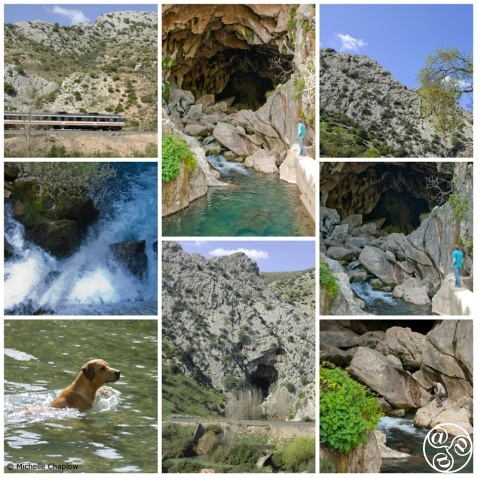
La Cueva del Gato (Cat's Cave) |
|
Cueva del Gato
by Chris Wawn, Dave Wood, John Gill and Chris Chaplow
The entrance of this cave can be seen from the railway as it heads north from Benaoján station two kilometres away. It's called the cave of the cat as its entrance is said to look like a cat's head. The Cueva del Gato is officially a Natural Monument in Andalucia.
This cave is the route of the Rio Guaduares, which takes an underground route entering in the Cueva de Hundidero ('fallen') on the other side of Montejaque, near the MA-8403 and only recommended to skilled potholers. The entire Hundidero-Gata system route is 7.8 km long and drops 200m. Famed for its potholing experience, it has been the scene of many deaths especially in the early years of sub aqua caving as a sport. Rising waters have too often trapped the unprepared.
However, for the curious, El Gato is a pleasant walk to an impressive limestone cave entrance. The entrance, by the way, is as far as you should go. A sign prohibits entry without official permission, and although there is no physical barrier to enforce the prohibition, it is wise to obey it.
Wild Swimming
There is a reasonable size natural pool in the river where only the brave wild swimmers take a dip as the water from the cave is very cold. Its waters are pure, unlike the Guadiaro, and so bathers come from vast distances. From here a short scramble up a narrow path to view the mouth of the cave and take photographs can be negotiated by anyone in sensible footwear.
The cave is of archaeological importance, although it has been heavily excavated and the remains removed. It's a lovely spot to visit during the heat of the summer and the leafy pool makes a welcome break from the sun. Many people come here for a picnic under the trees.
Human Occupation
The Cueva de Hundidero end's entrance cavern is called La Cueva de la Cabaña, it is 50m high and is where many prehistoric artefacts have been found. These include decorated jugs, some with handles and spouts, hundreds of stone tools, bracelets and necklaces which are now in the Seville Archeological Museum. There are surviving cave paintings hidden away is cracks in the rock, a red dear, a croup, and a human figure. The human is painted just above a shallow but distinct horizontal sloping crack in the rock face, as if to advise us, "the place to be, is above the waterline".
Stories of the Cueva del Gato cave being a haunt for Bandeleros (bandits) were reinforced by Manuel Barrón, in one of his mid 19 century romantic landscapes where the artist depicts a large cave opening, an exaggerated peak outside, inside a group of bandits, including a woman and a child, as they are disturbed by the Guardia Civil outside the cave. The painting contains features from both Cueva del Gato and the Cueva de Hundidero.

Presa de los Caballeros (Dam)
The natural water flow through the cave system was changed dramatically and unpredictably in 1920's with the construction of one of the first horseshoe shaped concrete wall dams in Spain. The Presa de los Caballeros (Dam) forms the Embalse de Montejaque (Montejaque reservoir) on the Rio Guaduares just upstream of the Cueva del Hundidero entrance. The dam was competed in 1927 but reservoir never fills due to seepage of water into the limestone rocks. The water reappeared inside the Hunidero-Gata cave system. Walkways, bridges and lighting were installed, some of which can still be seen by cavers today, to facilitate workers access for sealing openings with concrete. These construction workers were probably the first humans to fully traverse the 8km route between the two caves. The water sealing was without success and in the and early 1930's many international experts offered solutions. The Civil War stopped the project which was officially declared abandoned in 1944, the very year that the reservoir water reached 12m from the top of the dam. The useless and Civil Engineer's case study dam can be clearly seen today from the MA-8403. Today adventurous hikers do climb over the fence and ignore the warning signs the climb on the top of the dam for that special selfie now that Caminito del Rey has been rebuilt. Not to be outdone a tibetan style hanging walkway was constructed in 2024 across the face of the dam. Others just explore the reservoir bed which is usually dry. To reach Presa de los Caballeros from the Cat Cave it is necessaary to drive around the mountain via Montejaque and Benaojan.

Speleology
To the caver, entry to the actual system is best from the Montejaque side and requires various permits and a qualified guide.
back to Caves in Andalucia page
How to get there
To reach the cave entrance when coming from Ronda on the A-374 direction Seville. Carefully turn left onto the MA-7401 and after a few km, turn on the right hand side into the parking area ( one euro coin barrier only ) next to the Hotel cueva del Gato) located about 2 Kms before Estacion Benajoan. It is a five minute walk to the cave entrance along a well maintained path which now includes a wooden walkway "over the river" (no longer risking a dip on the stepping stones) and "under the railway line" (nowadays no need to risk all by crossing the railway tracks).

